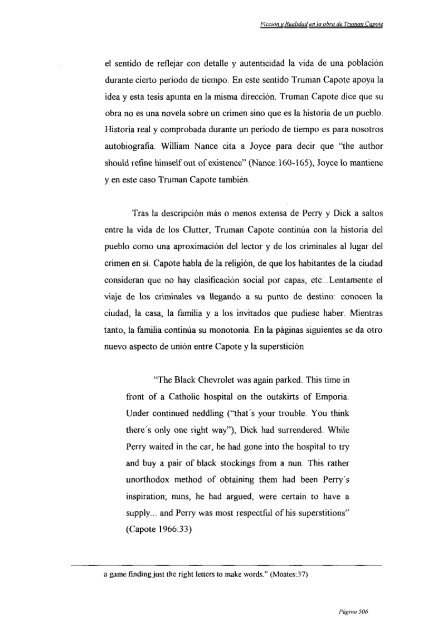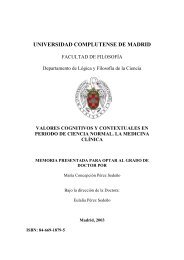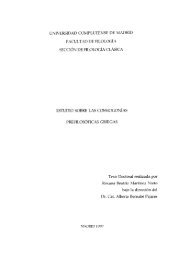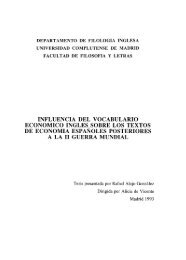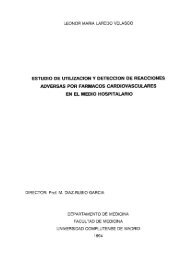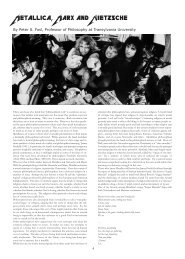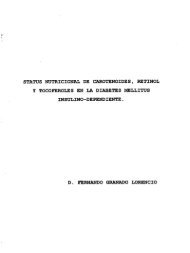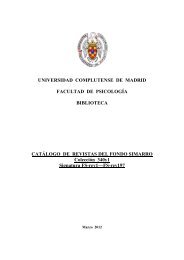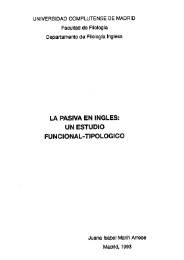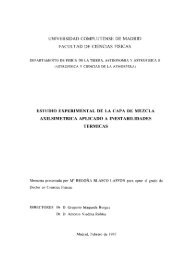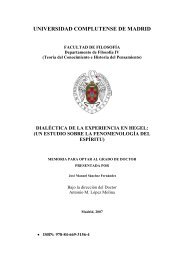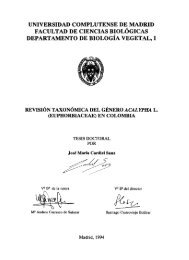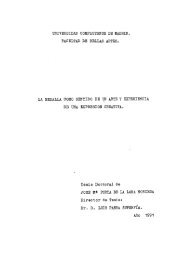ABRIR 3.2. La adolescencia - Biblioteca de la Universidad ...
ABRIR 3.2. La adolescencia - Biblioteca de la Universidad ...
ABRIR 3.2. La adolescencia - Biblioteca de la Universidad ...
Create successful ePaper yourself
Turn your PDF publications into a flip-book with our unique Google optimized e-Paper software.
Ficción y Realidad en <strong>la</strong> obra <strong>de</strong> 7n~,nan Capote<br />
el sentido <strong>de</strong> reflejar con <strong>de</strong>talle y autenticidad <strong>la</strong> vida <strong>de</strong> una pob<strong>la</strong>ción<br />
durante cierto período <strong>de</strong> tiempo. En este sentido Truman Capote apoya <strong>la</strong><br />
i<strong>de</strong>a y esta tesis apunta en <strong>la</strong> misma dirección. Truman Capote dice que su<br />
obra no es una nove<strong>la</strong> sobre un crimen sino que es <strong>la</strong> historia <strong>de</strong> un pueblo.<br />
Historia real y comprobada durante un período <strong>de</strong> tiempo es para nosotros<br />
autobiografia. William Nance cita a Joyce para <strong>de</strong>cir que “the author<br />
should refine himself out of existence” (Nance: 160-165), Joyce lo mantiene<br />
y en este caso Truman Capote también.<br />
Tras <strong>la</strong> <strong>de</strong>scripción más o menos extensa <strong>de</strong> Peri-y y Dick a saltos<br />
entre <strong>la</strong> vida <strong>de</strong> los Clutter, Truman Capote continúa con <strong>la</strong> historia <strong>de</strong>l<br />
pueblo como una aproximación <strong>de</strong>l lector y <strong>de</strong> los criminales al lugar <strong>de</strong>l<br />
crimen en sí. Capote hab<strong>la</strong> <strong>de</strong> <strong>la</strong> religión, <strong>de</strong> que los habitantes <strong>de</strong> <strong>la</strong> ciudad<br />
consi<strong>de</strong>ran que no hay c<strong>la</strong>sificación social por capas, etc.. Lentamente el<br />
viaje <strong>de</strong> los criminales va llegando a su punto <strong>de</strong> <strong>de</strong>stino: conocen <strong>la</strong><br />
ciudad, <strong>la</strong> casa, <strong>la</strong> familia y a los invitados que pudiese haber. Mientras<br />
tanto, <strong>la</strong> familia continúa su monotonia. En <strong>la</strong> páginas siguientes se da otro<br />
nuevo aspecto <strong>de</strong> unión entre Capote y <strong>la</strong> superstición<br />
“Ihe B<strong>la</strong>ck Chevrolet was again parked. This time in<br />
front of a Catholic hospital on the outskirts of Emporia.<br />
Un<strong>de</strong>r continued neddling (“thais your trouble. You think<br />
there’s only one right way”), Dick had surren<strong>de</strong>red. While<br />
Peri-y waited in the car, he had gone into the hospital to ti-y<br />
and buy a pair of b<strong>la</strong>ck stockings from a nun. Ihis rather<br />
unorthodox method of obtaining them had been Perry’s<br />
inspiration; nuns, he had argued, were certain to have a<br />
supp¡y... and Peny was most respectfifl ofhis superstitions”<br />
(Capote 1966:33)<br />
a game findingjust the right letters lo makc words.” (Moates:37)<br />
Página 506


